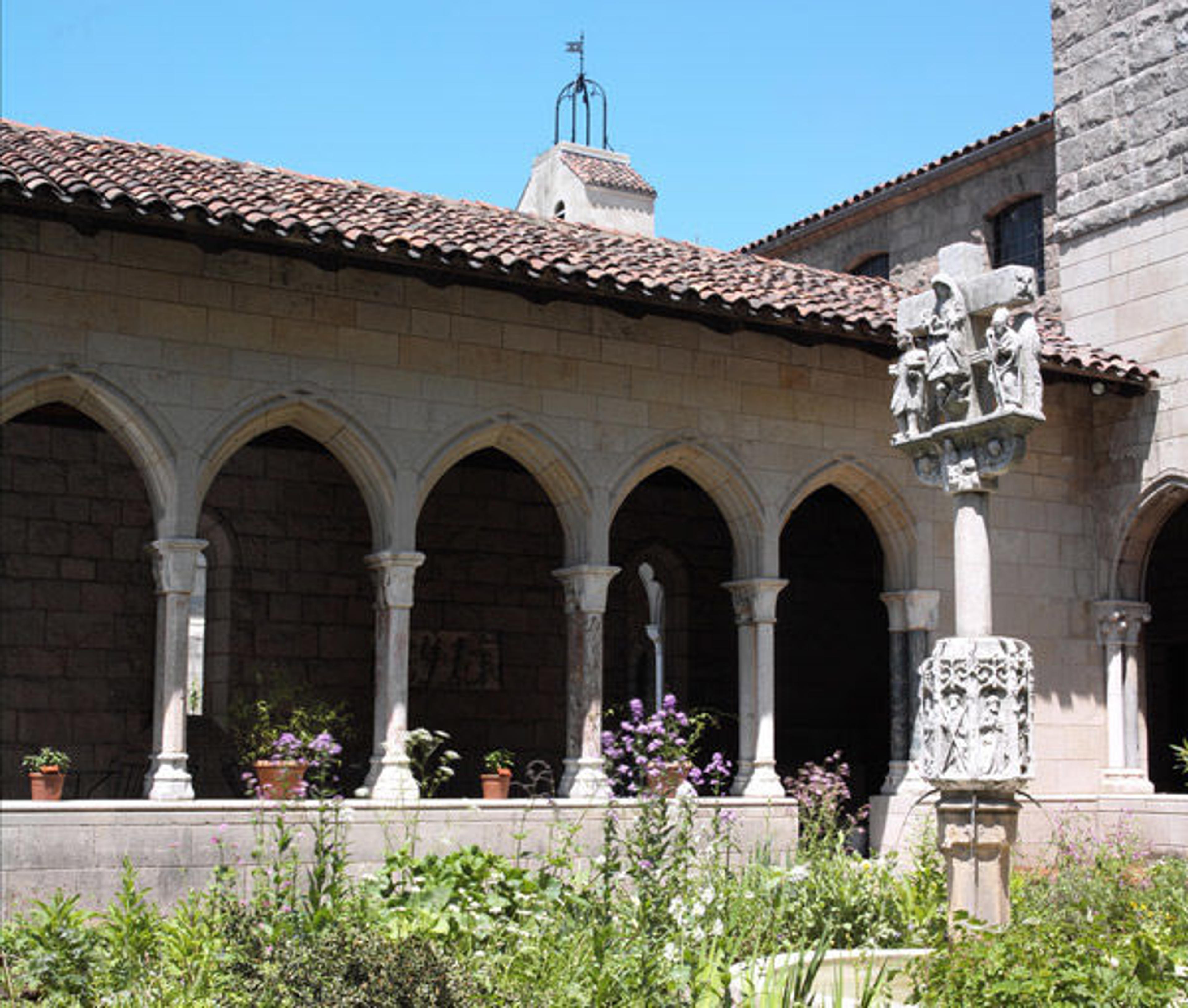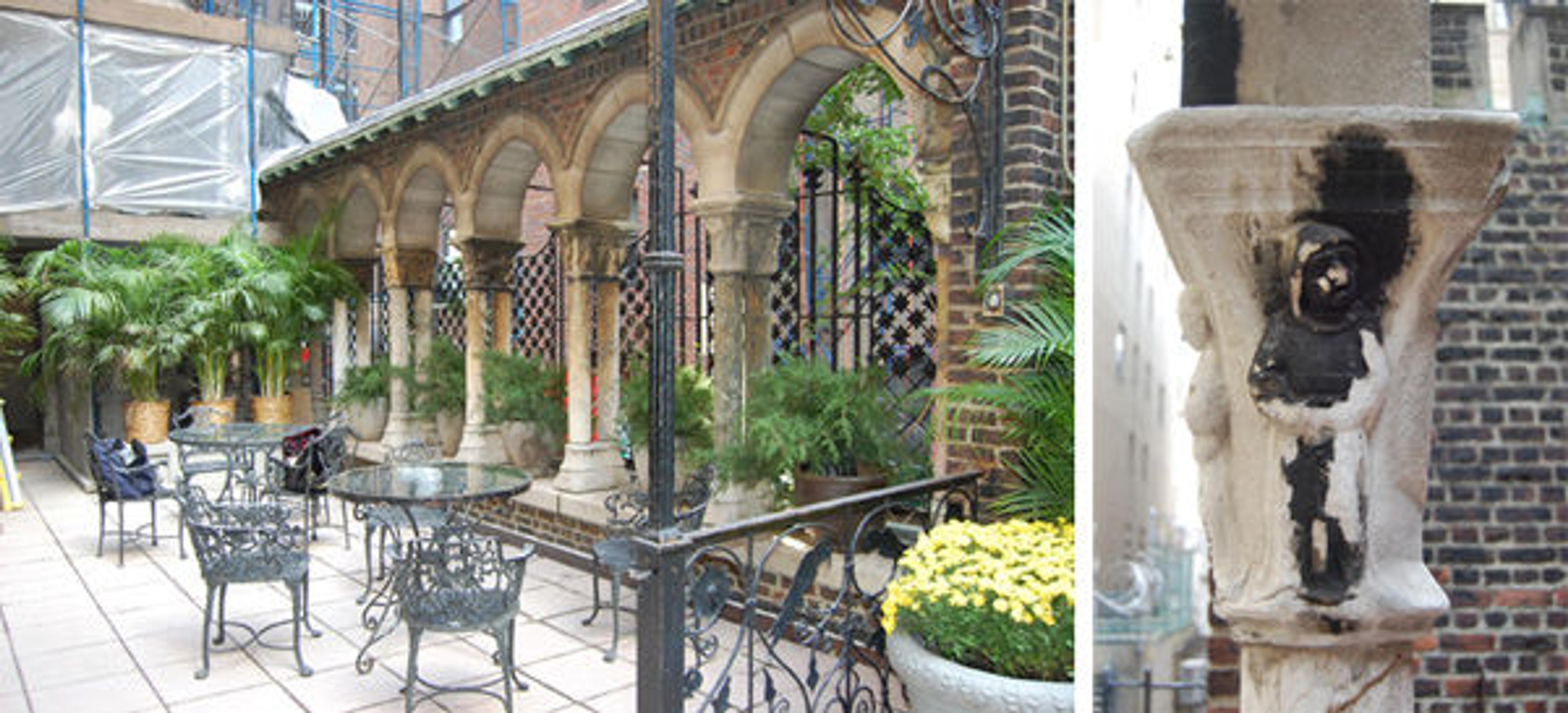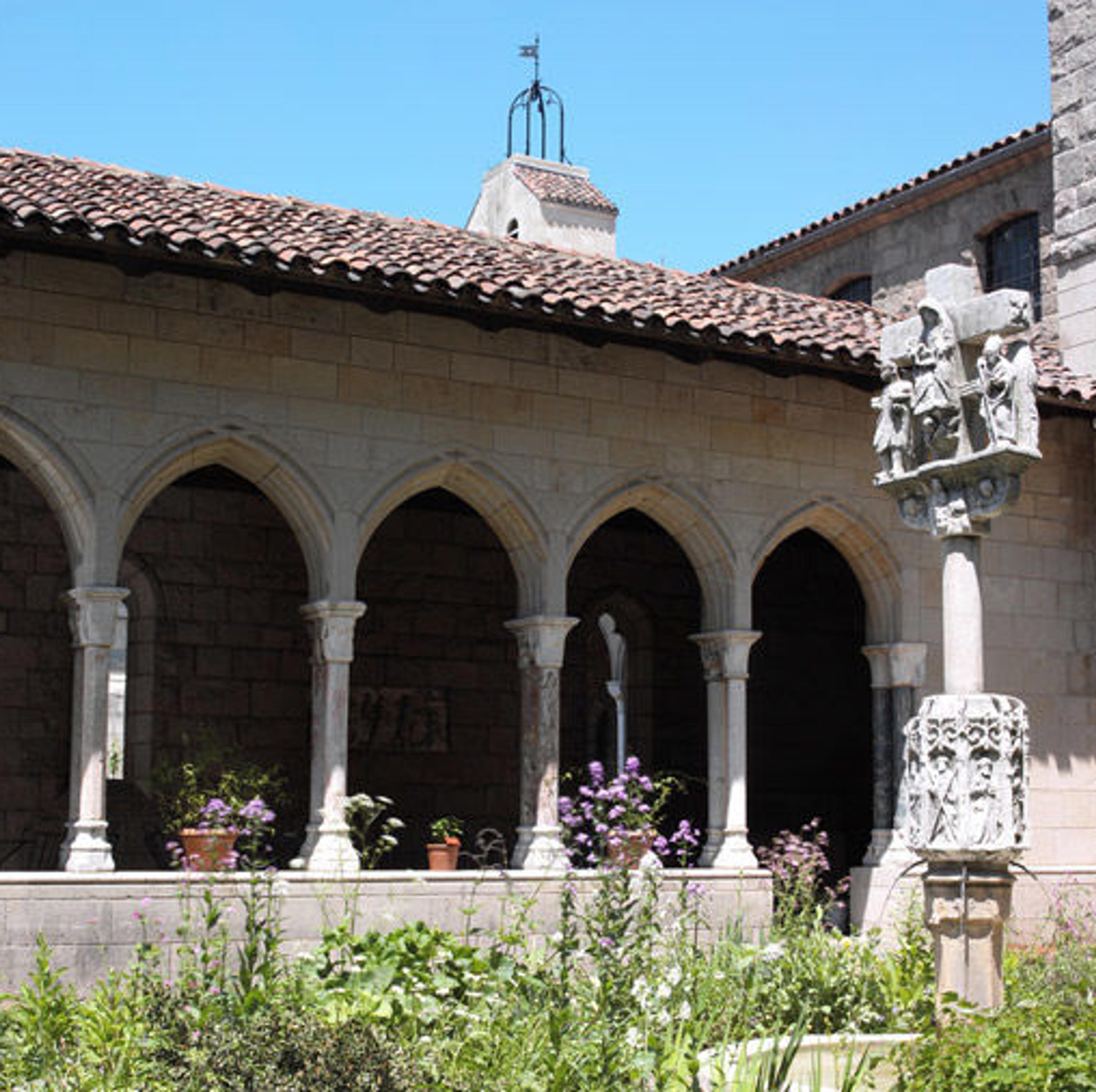
View of the Trie Cloister at The Cloisters museum and gardens
To clean or not to clean? That is the question.
The decision whether to clean a work of art is a difficult one for art conservators, as doing so is an irreversible action. Art that has withstood the vicissitudes of time comes to us with surfaces that show their age. While superficial layers may appear dirty, cleaning them sometimes removes information that is relevant to the history of the object. Thus, prior to making any treatment decision, conservators thoroughly study and analyze all aspects of a work of art.
In 1967, several capitals and bases from the Benedictine abbey Saint-Orens of Larreule (Hautes-Pyrénées, France) were generously offered to The Cloisters museum and gardens by the widow of Stephen C. Clark. They were later installed to complete the Trie Cloister, which is composed mostly of elements from the Carmelite monastery of Trie-sur-Baïse (previously Trie-en-Bigorre) in Hautes-Pyrénées. Two capitals in particular (67.155.24 and 67.155.25) were covered with a thick black crust. Prior to entering the Museum's collection, they had been exhibited on the exterior terrace of the Clarks' home at 46 E. 70th Street in Manhattan (now the Explorer's Club) from the mid-1910s to 1967. There they were exposed to atmospheric pollution, which causes the superficial deposit of airborne particles.

Left: The Explorer's Club's arcade, as photographed in 2010. Right: Detail of the black crust on one of the capitals. Photographs by Emeline Baude
The black crusts were aesthetically disturbing, but more importantly, they prevented natural exchanges such as water vapor transfer between the stone and its environment, a condition that could accelerate the deterioration of the stone substrate. The fragile surfaces under the crust were also in need of consolidation, a treatment that prevents the detachment of marble grains from the surface and improves the stone's strength and ability to resist further decay. This treatment could not be performed before cleaning, as one would not want to consolidate the black crust as well. Clearly, there was a strong case for cleaning the stone! But how was it to be performed?
Cleaning stone is often regarded as an easy task, but in reality, it is quite complex. The disintegration of the capitals' marble surfaces from exhibition in an outdoor environment (called "sugaring") was of greatest concern. In light of the stone's fragility, most cleaning methods (dry or wet, mechanical or chemical) were unsuitable. Chemical cleaning was attempted but deemed unsatisfactory.

Left: A double capital (67.155.24) in the south arcade of Trie Cloister, shown covered with thick black crust (prior to 2004). Center: After chemical cleaning. Right: After laser cleaning. Photographs by Emeline Baude
I decided to consider the use of laser cleaning, a method of thermal ablation that allows cleaning without physical interaction and is known to remove black crust formations homogeneously. Experiments with laser cleaning were first done on works of art by John Asmus in the early 1970s. Widely used in Europe, the method still raises certain questions in scientific and conservation circles. In particular, some have noted a yellow tone in stones cleaned with lasers.
"Laser" is an acronym for Light Amplification by Stimulated Emission of Radiation. Stone surfaces are usually cleaned with Q-switched Nd:YAG lasers with a light in the infrared spectrum (1064 nm wavelength). At this wavelength, the cleaning process is considered self-limiting, as it is largely incapable of affecting the stone surface. (Only the black components contained in the soiling residues will absorb the laser light, which is reflected away from the marble surface. The energy is thus insufficient to damage the original material, avoiding the problem of over-cleaning.) However, this wavelength is frequently blamed for the yellow appearance of the laser-cleaned surfaces. The causes of this discoloration are still not clearly established, but there are several current hypotheses; they present the yellowing as either a laser-induced phenomenon or as already present underneath the black crust and hence revealed after cleaning.
With these questions in mind, a testing protocol was devised at The Cloisters to evaluate the suitability of laser cleaning on the Museum's capitals. Close collaboration with the Museum's Department of Scientific Research enabled the testing of a laser system (Quanta System's Thunder Art laser), which is equipped with three different wavelengths: ultraviolet (355 nm), green (532 nm), and the previously mentioned infrared (1064 nm).
Samples were extracted from the stone and analyzed for identification of all materials present before and after laser cleaning. The level of cleaning attained with the laser technique at various wavelengths was scrutinized, as was its ability to preserve underlying superficial layers and maintain the original substrate.
An array of scientific tests offers some preliminary results. The yellow aspect of the stone after cleaning has been identified to be an organic matter that penetrated the stone prior to cleaning. (The nature of this organic material is still under examination; it could have been caused by a past treatment.) The calcite composing the marble is progressively transformed into gypsum due to its exposure to the environment. The outermost surface of marble originally composed of calcite is progressively transformed into gypsum. This process is called gypsification, and the chemically altered surface of marble is frequently referred to as its epigenic layer. This thin, epigenic layer is therefore intrinsic to the material and should be preserved during cleaning, as it preserves the capitals' carved details.

Sample from a double capital (67.155.25) in the west arcade of Trie Cloister examined with SEM/EDS. Map of a cross section showing the progressive weathering of the marble's surface
The "self-limiting" infrared wavelength was recognized to be the gentlest cleaning method, and was thus selected for use in laser cleaning. The treatment allows the removal of the black crust and the preservation of the underlying yellow epigenic layer. Further research and testing are necessary to assess the possibility of reducing the yellowing without damaging the uppermost stone layer.
Emeline Baude uses a laser operating at the infrared wavelength (1064 nm) to remove black crust from capital 67.155.25 on April 21, 2014. Video by Andrew Winslow
In the meantime, I hope many of you will appreciate the freshly revealed details of the beautiful capitals in the Trie Cloister and respect their slightly yellow surfaces, a key ingredient in the history of these works of art.

A double capital (67.155.25) in the west arcade of Trie Cloister before laser cleaning, at left, and after. Photograph by Emeline Baude
